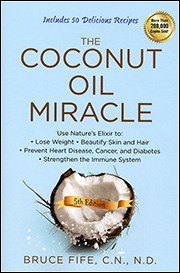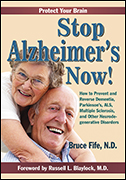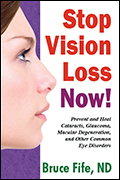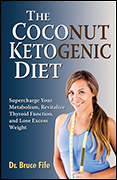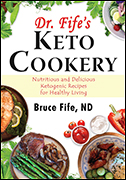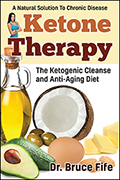|
E-Mail Edition Volume 14 Number 4 |
|||||||
|
Published Fall, 2017 Published by Piccadilly Books, Ltd., www.piccadillybooks.com. Bruce Fife, N.D., Publisher, www.coconutresearchcenter.org |
|||||||
|
If you would like to subscribe to the Healthy Ways Newsletter |
Contents
|
||||||
|
|
Overcoming Adult Epilepsy with the Ketogenic Diet
By
Jade Nelson
Chugging down the track, you overtook me, minding my own business, doing
eight year old things, it was like you zapped me inside my tiny little
body. I became extremely dizzy; the right side of my body went limp and
impossible to use.
You pushed me backwards and the hard floor caught me. A scream came from
deep inside me but it was trapped inside my brain unable to escape my
lips. You caused me to be alone, you taught me what true loneliness is.
You forced me down a dark tunnel where I could hear but I was silenced.
There was nothing but blackness all around me I could hear you
Epilepsy…..the sound of a train in the distance, it was you and you were
coming fast. Lying in the darkness, I felt you run through me. The
Train…yes you Epilepsy came to a painful stop, leaving me with a
pounding sledge hammer in my head. Emerging from the tunnel, I heard my
mom’s voice say, “Jade, it’s okay now.”
In the summer of 1987, I had my first seizure
a month shy of my eighth birthday. In the Spring of 1988 I went in for a
brain biopsy that determined I had a scar on the left side of my
temporal lobe and I was officially diagnosed with epilepsy.
|
||||||
|
These days, I think a lot about how my mum felt. I was diagnosed so young it didn’t feel like the end of something for me, it simply was a part of me and I didn’t know life before epilepsy. The only thing I knew was that “I just wanted to be normal.” In the beginning, my mum worried and was always watching. I think she was afraid I would have a seizure and fall and hurt myself or maybe even die. I recently talked with my mum about my epilepsy. She said, “I remember one day when I was telling you to be careful |
 Jade in the hospital at the time of her diagnosis. |
||||||
|
and
you looked at me and said ‘mum I just want to be normal’ and it broke my heart.
From that point on, I had to trust that everything would be okay and
allow you to live your life. If something did happen, I knew that you
were doing what you loved.”
I was so lucky to have a family that never held me back and believed I
was just as capable as anyone. I was also so lucky to have a mother who
was a nurse and made sure I was well educated on my diagnosis and my
medications and that it wasn’t something to keep quiet but to
understand. Her gift of self-empowerment through knowledge continues to
be a cornerstone of how I live.
I struggled at different stages in my life due to my epilepsy. While in
elementary school I become fearful that I would have a seizure and the
teachers wouldn’t know what to do, so I stopped going to school. That
fear went on for six months until the day the truant officer came to my
house and said, “If you don’t go to school you will be taken away from
your family.” Only the fear of being taken from my family outweighed the
fear of a seizure. The next day, my dad drove me to school. As he pulled
up to the front, I sat in the car battling the voice inside my head and
the deep sick feeling in my gut. Then the car behind us honked its horn.
To this day I am not sure what really made me do it but I jumped out of
the car and went to school and that fear was gone. From that day forward
I was stronger than the fear of having a seizure. I had only the choice
to move forward and know it would be okay whatever happened. Over the
next 20 years I would face judgement, other people’s fears, personal
embarrassment, and various challenges. My parents helped stand up for me
and fight those judgements until I was able to do it for myself. Each of
those experiences made me stronger and more determined to show the world
that epilepsy would not define me but drive me to change myself and the
world.
Over the years I changed medications, usually due to the fact that they
stopped controlling my seizures or the side effects were too great. I
have been on phenobarbital, Tegretol, Gabitril, Lamictal, Carbatrol,
Keppra, Vimpat, Zonisamide, Ativan, and Kolonipin. I was told by doctors
I would always have to be on medication. The side effects of these
medications affected me greatly. I required 10 hours of sleep, learning
was a challenge, I had constant headaches, and felt like I was on an
emotional roller coaster. Being diagnosed so young and being placed on
medication early, the side effects felt normal to me. It makes me so sad
to say that, but it was true, I didn’t know anything different. When I
got older, my biggest worry about my medications was cost. Over time, I
began to think more about what it was doing to me, and then five years
ago I began dreaming of what being off medication would feel like. I
wondered, would my personality be different? Would my stomach not always
feel sick? Would I sleep better? The list went on and on.
In
2014, after being seizure-free for 3 years, I had a seizure at swim
practice. I had been struggling with auras and my medication was
becoming really expensive even with insurance. So, I made the decision
to change medications and I went with the generic Zonisamide, knowing
full well that generics had a 20 percent variance and had caused issues
of breakthrough seizures (increased seizure activity after a period of
stability) for me when I was younger. We began the titration process and
over the next year I battled side effects like I had never experienced.
By the fall of 2015, I was diagnosed with gastritis. I had lost 25
pounds and my doctor diagnosed me as underweight.I also suffered from
brain fog, mood swings, depression, and fatigue. Each morning was a
struggle to get out of bed. I had to cut back on work. I cried daily. At
this point, I was ready to give in to my epilepsy and simply give up.
Spending my whole life fighting a diagnosis with medications, that felt
like they were killing me, was just too much. I was beyond tired of
living this life with epilepsy. In spite of all this, deep down I knew I
was luckier than some with my diagnosis and I did have various times in
my life that I was seizure-free, but the medication side effects were
hard and I wanted so badly to not need them. I was in despair.
In late 2015, I received a call from my younger sister saying, “You need
to look into the ketogenic diet.”This is where my life was about to
change. My dream of being off medication and the opportunity to finally
see what it was like to live a normal life, just might be possible. But
I was going to have to make drastic changes to my diet and lifestyle and
I wondered if I was ready.
I was aware of the ketogenic diet but had not considered it viable for me
because I thought of it as something for children; I was now in my
mid-30s. But I was at rock bottom and willing to do anything. I went and
saw my neurologist and told him I wanted to be on the ketogenic diet and
requested to be taken off Zonisamide and stay on only Carbatrol and
Vimpat. He sent me away with a titration schedule to take me off
Zonisamide and a link to the Charlie Foundation website, to learn more
about the diet. I was told to eat no more than 50 grams of carbohydrate
a day and as much protein as I wanted. For the first time in a long
time, I felt hopeful and I was ready “to heal myself.” Little did I know
it was going to take more than the scant information he provided.
I spent the next year figuring it out.
Each morning I spent hours researching online. My husband found apps to
help me, I ordered books, looked at websites, listened to podcasts, and
created a social media account to look for others who were using the
ketogenic diet for epilepsy. The issue I came up against was there were
not that many adults using keto to control their seizures.
Eventually, I came across a woman using the ketogenic way of eating to
control her seizures. We started talking weekly on the phone and
texting. Her support helped me get through the early days. She helped
quell my fears of having high enough ketones to control seizure
activity. She constantly reminded me that I still had a life to live and
didn't need to worry and focus on my food all the time. When I hit my
year mark on the diet, I finally found a dietician who added additional
guidance. Having
my family and a community to support me made surviving this journey
possible but it wouldn’t have happened if I wasn’t willing to do the
work and realizing it was not just a diet but a lifestyle.
Committing to this lifestyle did more than just control my seizures, it
set me free. I’ve created a new relationship with food and I have become
a fantastic cook. I started my own business that focuses on whole body
care and personal empowerment and I work with companies that encourage a
healthy lifestyle. I am driving now, something I had chosen in the past
not to do until my seizures were under better control. I am still on two
medications, Carbatrol and Vimpat, but I am on the least amount of
medication in my life.
I have found peace within myself. Physically, I feel amazing! I sleep
better, no longer feel constantly sick to my stomach, and my headaches
have lessened greatly. I feel good mentally and emotionally too. I no
longer have brain fog, my moods are even, I smile more, and my world has
truly opened up. My view of the world no matter what it throws at me is
manageable now. |
|||||||
|
Epilepsy doesn’t hold me back anymore and making the decision to use the
ketogenic diet to heal myself has become the driving force behind my
larger goal of changing the lives of those around me for the better. My
dream of educating, sharing my story and empowering individuals to not
let their diagnoses define them is a reality for me.
I
thought the ketogenic diet was the end of my journey of healing but it
has become my new beginning—a beginning that can, in time, allow me to
become completely medication free and be able to help others find the
success that I have. |
 Jade today. |
||||||
|
To learn more about Jade go to
https://jadenelson.net/ or
Instagram: @thetraininsideme.
|
|||||||
|
|
Coconut Oil: Nature’s Premier Superfood
As research continues, the number of health
benefits associated with coconut oil continues to grow. New research
shows coconut oil can prevent and reverse a wide range of chronic and
degenerative diseases and even slow aging.
In 2000, The Coconut Oil Miracle was published. In the book, I listed all the health properties and benefits mentioned in the medical literature and made sure to cite references. I also listed a few of the traditional benefits that have survived the test of time, again with citations to reliable sources. |
||||||
|
Not long after the book came out, readers began contacting me to share
their success stories using coconut oil. I love to hear success stores
because it lets me know that the research findings that I describe in my
books are being seen by users and that the benefits of coconut oil
aren’t just theoretical or isolated to laboratory settings, but can be
experienced by people in everyday life.
|
|||||||
|
improve
digestion, boost energy, aid in weight loss, improve blood cholesterol
and triglyceride values, lower blood sugar levels, and overcome
troubling skin conditions, all of which were described in my book and
were backed by scientific evidence. They were all believable and
helped to substantiate the research findings described in my book.
However,
some people would tell me how coconut oil had helped them with a
health issue that I had not mentioned and for which there were no
studies or scientific rational to support the effect they reported. I
viewed these reports with some skepticism. By nature I am very
skeptical of health claims on any product and I need a solid
scientific explanation as to why it works or see some valid published
studies before I’m willing to accept it. Too many health claims are
made for products that have no basis in science and are supported only
by unproven theories or personal stories from enthusiastic believers.
Such claims are notoriously unreliable. People can become so excited
about a new product that the positive effects they report are simply
in their imaginations.
I made a
mental note of these stories, but paid little attention to them. Over
time, however, I began to hear a few stories repeated over and over
again by different people. I could ignore a single isolated incident,
but when numerous people began telling me how coconut oil helped them
or family members with the same problems, I began to take notice. That
was too much of a coincidence to ignore. Simply because there were no
published studies to substantiate these effects, at that time, it
didn’t mean that they were invalid. It just meant that more studies
needed to be done.
Some of
these stories involved conditions like Parkinson’s disease, MS,
diabetes, cancer, and epilepsy. For many years epilepsy had been
successfully treated using a special diet known as the ketogenic diet.
The ketogenic diet is one that is very low in carbohydrate and high in
fat. Carbohydrate in our diets are converted to glucose in the body and
glucose is the primary fuel for our cells. A diet lacking carbohydrate
must rely on stored fat for most of its energy needs. Therefore, body
fat is broken down into fatty acids to be used as fuel in the absence
of glucose. Some of these fatty acids are converted into another type
of fuel known as ketone bodies or ketones. The brain has a particular
need for ketones in the absence of glucose. Ketones themselves have
therapeutic effects on the entire body but especially the brain. This
is why the ketogenic diet has been so successful in treating epilepsy.
In recent years the diet has proven equally as successful in treating
other neurological conditions such as Parkinson’s disease, MS, and
Alzheimer’s disease. Ketones also have positive effects on diabetes,
cancer, and other health problems. MCTs are naturally ketogenic. When coconut
oil is consumed, many of the MCTs in the oil are automatically
converted into ketones regardless of the amount of carbohydrate in the
diet. Here was the connection between neurological disorders, like
epilepsy, and coconut oil. I began to research the ketogenic diet and
its relationship to MCTs. This lead me to the missing link between
coconut oil, and many of the success stories people were telling me
about that otherwise had no scientific justification.
The
original, (or classic ketogenic diet) was developed in the early 1920s
specifically to treat epilepsy. Unlike drugs used to treat the
condition, the ketogenic diet allows the brain to heal, and in many
instances, can dramatically reduce and even completely eliminate
seizures. However, the diet is harsh. To reduce blood glucose and
promote the production of ketones from stored body fat, dietary
carbohydrate was reduced to 2 percent of total calories. To make up
for the missing carbohydrate calories and to supply additional fat for
the production of ketones, fat intake was increased to at much as 90
percent of calories. The remaining 8 percent of calories came from
protein. Although the diet is very therapeutic, it was difficult to
manage. Meals took special efforts to prepare and quickly became
unappetizing. Many patients could not tolerate the diet for long, and
as more drugs became available, they opted to go the drug route.
In the
1970s it was discovered that MCTs from coconut oil were naturally
ketogenic, that is, they could be converted into ketones regardless of
how much carbohydrate one ate. The use of coconut and MCT oils as the
primary source of fat in the ketogenic diet has reduced the
requirement for total fat calories to about 50 to 60 percent, with the
same level of effectiveness as the classic ketogenic diet. This has
allowed for the addition of more carbohydrate and protein. The
modified MCT ketogenic diet, is better tolerated because it allows a
greater variety of foods to be eaten, which makes the diet more
palatable and nutritious. It also makes the diet far easier to
implement without special training from a dietitian, so anybody can
benefit from a ketogenic diet with some basic instructions.
Replacing
some, or most, of the fats in the ketogenic diet with coconut or MCT
oils, enhances the therapeutic effects of the diet. Eventually, it was
discovered that if you consume enough MCTs in an ordinary diet, you
could raise blood ketones to mild therapeutic levels with results
approaching that of the ketogenic diet.
Studies
have uncovered many health benefits associated with ketones. Ketones
are considered a superfuel for the body, providing up to 25 percent
more energy than glucose. They improve oxygen utilization by the
cells, and increase blood flow to the brain by 39 percent, increasing
circulation and oxygen delivery to this vital organ. Unlike glucose,
ketones are easily absorbed into cells without the need of insulin,
and therefore, are not hampered by insulin resistance. They enhance
immune function and stimulate the production of white blood cells.
They have a strong anti-inflammatory action, and signal genes to
increase production of protective antioxidants, such as glutathione.
Ketones activate special proteins in the brain that regulate brain
cell function, maintenance, and repair. Ketones being made of fat,
provide the basic lipid building blocks for the growth of new brain
cells. They protect the brain from the sticky amyloid plaque deposits
that develop in Alzheimer’s patients. They interfere with cancer
cells’ ability to absorb glucose, increase cancer cells’ sensitivity
to chemo and radiation therapy, and protect against the awful side
effects caused by these therapies. Ketones improve insulin sensitivity
and help moderate blood sugar. The list goes on and on. Many of the benefits that have been documented with ketones, have in recent years also been documented with the consumption of coconut oil. It has become clear that many of the health benefits people where relating to me from the use of coconut oil came as a result of the ketogenic effect of the oil, and there was good science to back it up. In fact, there is far more research on the effects of ketones and the ketogenic diet than there is on coconut oil. This has led me to investigate the ketogenic side of coconut oil and to write a series of books based on this new data: |
|||||||
|
If you would like to learn more about any of the books shown above, just click the cover. |
|||||||
|
Of course,
all the claims in these books are backed by published studies and
further fortified by actual success stories. Each of these books
describes the benefits of ketones and the ketogenic diet, and how the
incorporation of coconut oil into the diet can successfully treat many
previously untreatable conditions. My most recent book,
Ketone Therapy, describes the therapeutic uses of ketones and
how coconut oil and the ketogenic diet, separately or together, can
prevent, stop, and reverse many chronic, degenerative conditions and
produce an anti-aging effect—again, all documented by published
research.
I would like
to point out that only oils that consist primarily of MCTs, namely
coconut and palm kernel oils, have this ketogenic effect. None of the
above benefits can be found with olive oil, flaxseed oil, krill oil,
borage oil, or any other so-called healthy oil because none of these
other oils contain any MCTs. Coconut oil is truly a superfood that
surpasses all other dietary oils in terms of health benefits. In fact,
there is probably no other food, in any category, that provides as many
benefits as coconut oil does.
|
|||||||
|
|
The
Anti-Aging Effects of Ketones and Coconut Oil
Youthfull senior citizens — Storyblocks
Whether
ketones come from eating a very low-carb ketogenic diet, or from coconut
oil (coconut ketones), their therapeutic effects are the same. Ketones
have been shown to improve all of the health markers doctors’ measure
when evaluating a patient’s health status. Ketones do the following:
• Reduce
blood glucose and improve insulin sensitivity
• Reduce
blood insulin levels
• Raise HDL
cholesterol
• Reduce
blood triglycerides
• Increase
large, beneficial LDL cholesterol
• Reduce
small, dense, potentially harmful cholesterol
• Reduce body
weight and body mass index (BMI)
• Reduce
waist circumference (reduce abdominal or visceral fat)
• Normalize
blood pressure
• Reduce
cholesterol ratio (total cholesterol/HDL)
• Reduce
triglyceride ratio (triglyceride/HDL)
• Reduce
C-reactive protein (a marker for systemic inflammation)
• Increase
human growth hormone (HGH) levels
• Reduce
advanced glycation end products (AGEs)
• Reduce free
radicals and oxidative stress
All of these
contribute to improved health and longer lifespan. AGEs and excess free
radicals (oxidative stress) have long been implicated as major
contributors to the aging process, and reducing their influence has been
viewed as a key feature in preserving good health and extending
healthspan (healthy lifespan). Human growth hormone (HGH) has gained the
reputation of being an anti-aging hormone. We have high levels of HGH in
our youth, but levels decline with age. HGH
supports bone mineralization and density, maintains and increases muscle
mass, reduces fat production and storage, supports immune function,
improves memory and cognitive function, reduces cardiovascular risk
factors, and promotes rapid healing from injury and illness.
Bodybuilders and athletes often use the synthetic version of the hormone
to aid in weight loss, boost muscle strength, and improve athletic
performance. You don’t need to inject a synthetic hormone to accomplish
this, therapeutic levels of ketones from a proper ketogenic diet can
stimulate your own body to produce natural HGH—the kind most suitable
for your body, without all the side effects associated with the
synthetic versions.
Studies have
repeatedly shown that the ketogenic diet slows down the aging process
and extends healthy lifespan. For decades researchers have studied the
life-extending effects of calorie-restricted diets, where total daily
calorie intake is reduce by 20 to 40 percent. In animals, lifespan has
increased by as much as 40 percent simply by reducing the amount of food
they eat. Age-related conditions, such as diabetes, heart disease, and
failing memory, are also suppressed. Studies have shown this same effect
can be duplicated simply by reducing carbohydrate consumption, without
actually reducing total calorie intake.1-2
A recent
study suggests that a ketogenic diet could increase healthspan by as
much as 10 years. In the study mice were assigned to one of three diets:
a ketogenic, low-carb, or control diet. As the mice aged, only those on
the ketogenic diet maintained their youthful physiological function. The
high-fat ketogenic diet significantly increased lifespan compared to the
other two diets. These mice saw a 13 percent increase in lifespan, which
would translate into 10 extra years in humans.3
If you are
experiencing symptoms of premature aging, a ketogenic diet or the
consumption of therapeutic levels of coconut oil may not only slow the
aging process but possibly reverse it! Many people with high blood
pressure, elevated blood sugar and insulin levels, unhealthy cholesterol
levels, high oxidative stress, excess body fat, and other symptoms of
aging and poor health, have been able to successfully reverse all of
these conditions, essentially turning back the clock on the aging
process. You can learn more about all of this in my book Ketone Therapy: The Ketogenic Cleanse and Anti-Aging Diet.
References
1. Veech, RL,
et al. Ketone bodies mimic the life span extending properties of caloric
restriction. UBMB Life 2017;69:305-314.
2. Newman,
JC, et al. Ketogenic diet reduces midlife mortality and improves memory
in aging mice. Cell Metab 2017;26:547-557.
3. Roberts,
MN, et al. A ketogenic diet extends longevity and healthspan in adult
mice. Cell Metab 2017;26:539-546.
|
||||||
How Well Are You Aging? |
|||||||
|
Although we all age chronologically, we do not
age at the same rate. A healthy 60-year-old can be “functionally” as
young as a 45-year-old, while a sickly 40-year-old could have a body
comparable to a 70-year-old. Those people who live the longest are
generally free of debilitating disease for most of their lives. They are
functionally younger than those people whose bodies degenerate and die
before their time. Several “biomarkers” are used by scientists as a way of measuring functional age in people. By measuring a person’s biomarkers, functional age can be determined. There are many types of biomarkers, some involving equipment and measurements that require medical supervision. Some you can do yourself in your own home. Below are a few biomarker tests you can take to roughly determine your |
 Youthfull woman — Storyblocks |
||||||
|
functional age. Please be aware that there is
wide variation in the results on these tests and they shouldn’t be taken
as absolute evaluations of your health status, but they will give you a
calculated estimate. After taking each individual test we will
summarize the results to determine your overall functional age. Please
note that this test is designed for people age 20 and above.
Skin Elasticity Test As we age, our skin loses it elasticity due to
the lifelong exposure to AGEs and oxidative stress. Significant changes
usually occur at about the age of 45. It is a good marker for how the
skin changes after this age. At younger ages, there are only slight
changes. For this test, pinch the skin on the back of
your hand between the thumb and forefinger for five seconds. Let go and
time how long it takes for the skin to completely flatten back out. The
shorter the time, the younger your functional age. Compare your results
to the table below. |
|||||||
|
Time (sec) 1-4 5-6
10-15
|
Functional Age (years)
|
||||||
|
Static Balance Test This test is considered the best biomarker
among the do-it-yourself measurements. There is a full 100 percent
decline with age. The static balance test measures how long you
can stand on one leg with your eyes closed before losing your balance. For this test, you must be either barefoot or
wearing low-healed shoes. Stand on a hard surface with both feet
together, close your eyes, and lift one foot about six inches off the
ground. If you are right-handed, lift your left foot and if you are
left-handed, lift your right foot. The raised knee should be bent at
about a 45-degree angle. Don’t move, just stand on one foot with your
eyes closed. Have someone time you. When you lose your balance and touch
the ground with the other foot, record the time. Do the test three times
and take an average. Check your results with the table below. |
|||||||
|
Time (sec) 30 or more 25 16 10 7 5 |
Functional Age (years) 20 30 40 50 60
|
||||||
|
Strength Test As we age, we tend to lose muscle mass and
strength. Muscle mass starts declining at about age 40 and speeds up
after about 50. Loss of strength increases risk of falls and makes
performing routine tasks, such as carrying groceries, more difficult. Push-ups are a good test of overall strength
because they not only involve muscles in the upper body but the stomach
and back as well. When doing push-ups, keep the back straight and head
up. The chest should come down to a distance equal to the size of a
clinched fist, or about 4 to 5 inches from the ground. Arms should be
fully extended with each push-up. Men should have only their toes and
palms of their hands on the floor. Women should rest their knees on the
ground. Do as many push-ups as you can. |
|||||||
|
Number of Push-ups |
|||||||
|
Men 51 41 34 28 24 20 |
Women 37 32 26 20 9 8 |
Functional Age (years)
|
|||||
|
Flexibility Test How far you can reach beyond your toes from a
sitting position can indicate how stiff your arteries are. In a healthy
body the arteries are soft and elastic. They can easily stretch with
body movement, expand, and contract when necessary to facilitate proper
blood flow, and moderate blood pressure. As we age, the arteries tend to
become stiff. Blood flow is restricted, blood pressure rises, and risk
of cardiovascular disease increases. Stiffness in the midsection of the body seems
to reflect arteries that have begun to lose their elasticity. Those
people who cannot reach to or beyond their toes are more likely to have
higher blood pressure and suffer from a heart attack or stroke. For
people 40 years and older, even if they’re a little overweight, trunk
flexibility is a good indicator of arterial flexibility. To do this test, sit down with your back
against a wall, and with your legs on the floor in front of you. Try to
touch your toes without bending your knees. Measure the distance from
finger tips to toes. Compare your results with the chart below. |
|||||||
|
Distance (inches) 0 1 2 3 4 5 |
Functional Age (years) 39 or younger 45 55 75 85 90 |
||||||
|
Driving Response Test This test measures your reaction time. It
evaluates how quickly your brain and nerves respond to a stimulus. This test takes you to another website where
you will test your reactions while driving down the street in a car. A
stop sign will suddenly appear and you must put on the breaks as quickly
as possible. The time it takes for you to complete this action indicates
your functional age. Practice once or twice before recording your score.
For the best results, take the test three times, add your scores and
divide by three, this will be your score for the Driving Response Test.
To take the test,
go here
https://www.justpark.com/creative/reaction-time-test/. When you get
to the site, click the down arrow
to begin the test. After taking the Driving Response Test, come back to
this page to finish the test. Take the test now,
before reading any further. How well did you do? It is not unusual to score
below your chronological age in some of the above tests and over for
others. Evaluating the results of all the tests together can give you a
reliable estimation of your functional age. You will now combine the scores on each of the
five tests to determine your overall functional age. In two of the
tests, the Skin Elasticity and Flexibility Tests, the youngest ages you
could score are 44 and 39 respectively. If you scored the minimum on
either of these tests, you will need to adjust the score according to
your chronological age, as described below.
If
your score on the Skin Elasticity Test was 44 or younger, and your
chronological age is 44 or younger, use your true age to tally your
total score, otherwise, use your actual score. If your score on the Flexibility Test was 39 or
younger, and your chronological age is 39 or younger, use your true age
in the calculations, otherwise use your actual score. Add up the scores on each of the five tests,
then divide by five to arrive at your functional age. See the example
below. For this example let’s assume the subject is 38 years old. |
|||||||
|
Test Skin Elasticity Test Static Balance Test Strength Test Flexibility Test Driving Response Test |
Functional Age (years) 44, use actual age of 38 years
30 30 45
42 |
||||||
|
|
Total Score 38+30+30+45+42=185
Divide 185 by 5 gives an overall score of 37.
This person is 38 years old but has a functional age of 37. If you scored a functional age older than your
chronological age, you are in need of help and probably need to consume
more coconut oil or go on a ketogenic diet. |
||||||
|
Do you have friends who would like this newsletter? If so, please feel free to share this newsletter with them.
If this newsletter was forwarded to you by a friend and you would like to subscribe, click here.
Copyright © 2017, Bruce Fife. All rights reserved.
|
|||||||
